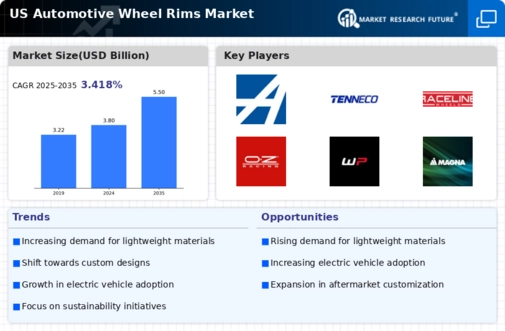The automotive wheel-rims market is currently characterized by a dynamic competitive landscape, driven by innovation, sustainability, and technological advancements. Key players such as Alcoa (US), HRE Wheels (US), and BBS (DE) are actively shaping the market through strategic initiatives. Alcoa (US) focuses on lightweight aluminum solutions, enhancing fuel efficiency and performance, while HRE Wheels (US) emphasizes bespoke designs and high-performance applications, catering to the luxury and sports car segments. BBS (DE), renowned for its motorsport heritage, continues to innovate with advanced manufacturing techniques, positioning itself as a leader in high-performance wheel technology. Collectively, these strategies foster a competitive environment that prioritizes quality, performance, and customization.
In terms of business tactics, companies are increasingly localizing manufacturing to reduce lead times and enhance supply chain resilience. This approach is particularly evident in the context of a moderately fragmented market structure, where the influence of key players is significant but not overwhelming. The collective actions of these companies indicate a trend towards optimizing supply chains and enhancing operational efficiencies, which are crucial for maintaining competitive advantage in a rapidly evolving market.
In October 2025, Alcoa (US) announced a partnership with a leading electric vehicle manufacturer to supply lightweight aluminum wheel-rims, aimed at improving vehicle efficiency and sustainability. This strategic move not only aligns with the growing demand for eco-friendly automotive solutions but also positions Alcoa (US) as a pivotal player in the electric vehicle segment, potentially increasing its market share in a burgeoning industry.
In September 2025, HRE Wheels (US) unveiled a new line of forged wheels designed specifically for electric vehicles, incorporating advanced materials that enhance performance while reducing weight. This initiative reflects HRE's commitment to innovation and its responsiveness to market trends, particularly as the automotive industry shifts towards electrification. By catering to this niche, HRE Wheels (US) is likely to strengthen its brand presence and attract a new customer base.
In August 2025, BBS (DE) launched a new manufacturing facility in the US, aimed at increasing production capacity and reducing delivery times for its high-performance wheel-rims. This strategic expansion not only enhances BBS's operational capabilities but also signifies its commitment to meeting the growing demand for premium automotive components in the North American market. Such investments are indicative of a broader trend where companies are prioritizing local production to enhance responsiveness and customer satisfaction.
As of November 2025, the automotive wheel-rims market is witnessing trends that emphasize digitalization, sustainability, and the integration of artificial intelligence in manufacturing processes. Strategic alliances are increasingly shaping the competitive landscape, enabling companies to leverage shared resources and expertise. Looking ahead, it appears that competitive differentiation will evolve from traditional price-based competition to a focus on innovation, technological advancements, and supply chain reliability. This shift suggests that companies that prioritize these elements are likely to thrive in an increasingly competitive environment.






















Leave a Comment